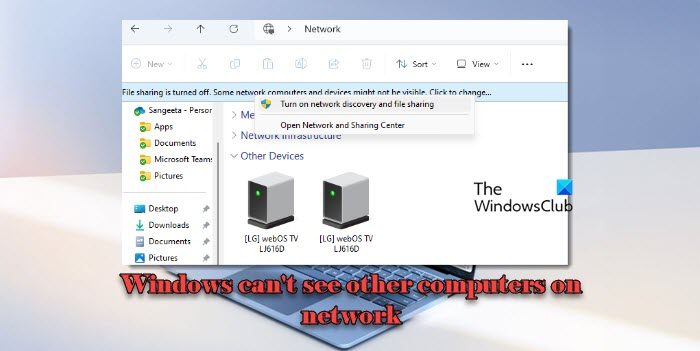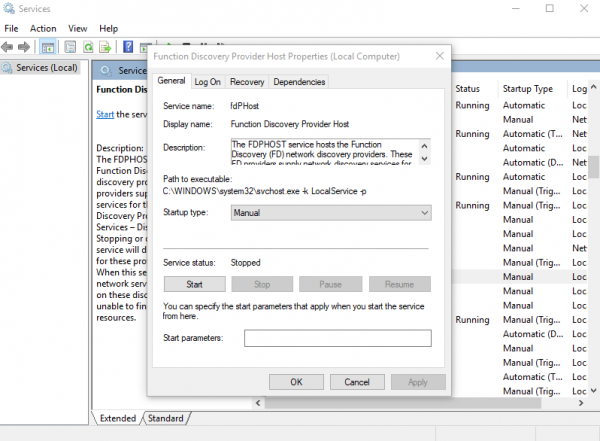The Windows File Explorer has been included and shipped with every generation of the Windows Operating System and has undergone many changes. The File Explorer that comes with Windows 11/10 is not just for browsing the local hard drive partitions. It can also be used to browse files and folders in a local or even a remote network. This makes it one of the most important components for Windows for regular and power users.

Can’t see other computers on network
Unfortunately, some users tend to report that File Explorer gets some issues while connecting to other devices on the Local Network. This is due to the fact that the Windows Service that supports this feature gets issues in triggering up. The name of this service is fdPHost and is called Function Discovery Provider Host. It is not to be confused with a similar service called Function Discovery Provider which has similar functionality.
About this service, Microsoft describes it as,
The FDPHOST service hosts the Function Discovery (FD) network discovery providers. These FD providers supply network discovery services for the Simple Services Discovery Protocol (SSDP) and Web Services – Discovery (WS-D) protocol. Stopping or disabling the FDPHOST service will disable network discovery for these protocols when using FD. When this service is unavailable, network services using FD and relying on these discovery protocols will be unable to find network devices or resources.
In simple words, the Function Discovery Provider Host service is essential for network discovery and sharing in Windows 11/10.
Explorer cannot connect to other devices on the local network
First of all, ensure Network Discovery and File Sharing are enabled on your system. Next, you need to ensure that the Function Discovery Provider Host service is correctly configured and running.
Hit the WINKEY + R button combination or search for Services in the Windows Search box. This will launch the Services window.

Now locate the service named Function Discovery Provider Host.
Right-click on it and click on Properties.
If the service is already running, stop it.
Then change the Startup Type to Automatic (Delayed Start) and then Start the service.
Click on Apply and then click on OK to save the changes.
Reboot the computer for the changes to take effect.
Now check if your issue is solved.
Read: Network Connections Folder is empty in Windows.
Why is my PC not showing on other computers in the network?
If your PC is not showing up on Network, make sure Network Discovery and File Sharing are enabled on your Windows 11/10 PC, your network is set to Private, your computer is in the same workgroup as other PCs and network services are running and set to Automatic (Delayed Start). If the issue persists, check for any firewall settings blocking Network Discovery and consider restarting both your router and computer to refresh network connections and resetting network protocols to their default settings.
How to see other PCs on network?
You may other PCs on your network in the Network section of File Explorer. Press the Win + E keys to open File Explorer. Click on Network in the left panel. You should see other computers and devices that are currently connected to your network under the Network section. If you don’t see any computers listed, ensure that network discovery and file sharing are enabled on your Windows 11/10 PC and that all PCs are in the same workgroup. If needed, click on ‘Change’ to modify the workgroup name and restart your computer.
Read Next: Enable or Disable Network Discovery or Sharing in Windows.
Sorry, that did not work. My Windows 10 machines and NAS do not appear as computers with available shares. The NAS is only seen as Other Device.
Thanks. It worked!!!!!
Maybe your other devices need to be configured again? Did you try that?
I used to be able to see all the computers, but an Update must have changed something. Anyway, I checked the machines which even with SMB 1/CIFS enabled did not see all the computers, and then I enabled SMB Direct and BAM!!, all the machines now appear on the network. SMB Direct is an additional Windows feature which can be turned on through Control Panel’s Programs and Features.
Another thing that doesn’t help with this is that Windows 10 seems to turn on password-protected sharing with every feature update, regardless of how the User had it set previously. This then breaks any network sharing that doesn’t use a password. This happens EVERY time a feature update is installed. As an Insider, it also happens every time a new build is released. Obviously this is on a machine actually sharing folders.
It works for me. Thanks.
Hey folks. In case it helps the ton of people this doesn’t work for … here’s an answer.
First my environment – pretty simple – just a Win10 enterprise PC which is basically a server for the house – wanted a couple of laptops and a couple of desktop machines to have full access to read/write from shared folders. One of the laptops was on wifi – the other and all desktop machines hardwired ethernet.
All was just fine till I refreshed (reset) the server as it was running poorly. Suddenly, all my shares went out. I tried everything suggested everywhere – reset my NICs and equipment, autostarted FDPH and a number of other related services. Set sharing on both drives and individual folders to ‘everyone’ rather than defined users to see if that helped. Confirmed sharing and set up credentials on every machine for every user. Updated the windows Hosts files to explicitly authorise the machines in question. You get the picture – If you can blog it, I tried it. Nothing worked EXCEPT on the wifi connected laptop – that suddenly started seeing the server shares when I disabled SMB1 on that specific machine. Go figure.
So – I tried the same thing on the other laptop, which is exactly the same model of machine running exactly the same (win10pro) version of Windows but it still couldn’t see the shares. I went through every friggin’ setting with the machines side by side right down to what was autostart vs autostart (delayed) and there was absolutely no difference. Then it occurred to me after hours of doing this and just being stumped – the only difference was one was on wifi, one was on ethernet. I then simply unplugged that laptop from the dock, rebooted it on wifi without changing anything else and hey presto – all my shares were there and fully accessible.
With that revelation, I went to my garage, rummaged through a few boxes and found an old USB N wireless dongle I haven’t used for years, plugged it into one of my desktop machines and pulled the ethernet cable from the back and guess what – everything suddenly comes perfectly.
From there, I went onto ebay, bought a couple of decent (and cheap) USB3 AC wifi dongles, plugged them into all my desktop computers and everything just works again at last.
Anyone reading this from Microsoft – firstly shame on you for making this so hard for people – secondly shame on you for not testing your product properly for such a basic feature – thirdly shame on you for trashing homegroups without giving decent notice or advice to everyone at the time and lastly should you be trying to fix this issue – the problem is with ethernet connections – wifi doesn’t have this issue on any of the machines I have.
Hope this helps everyone … Regards, Dave